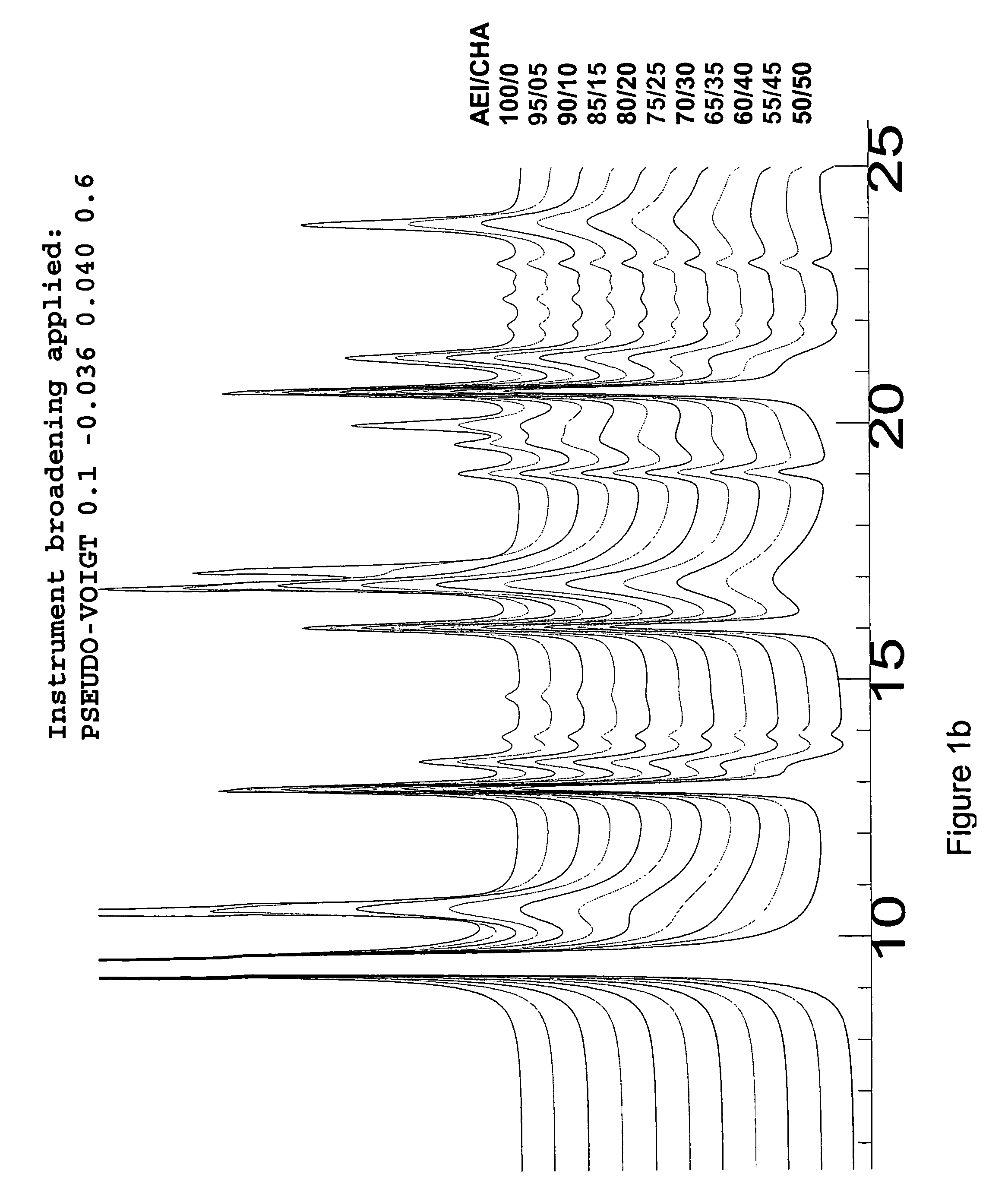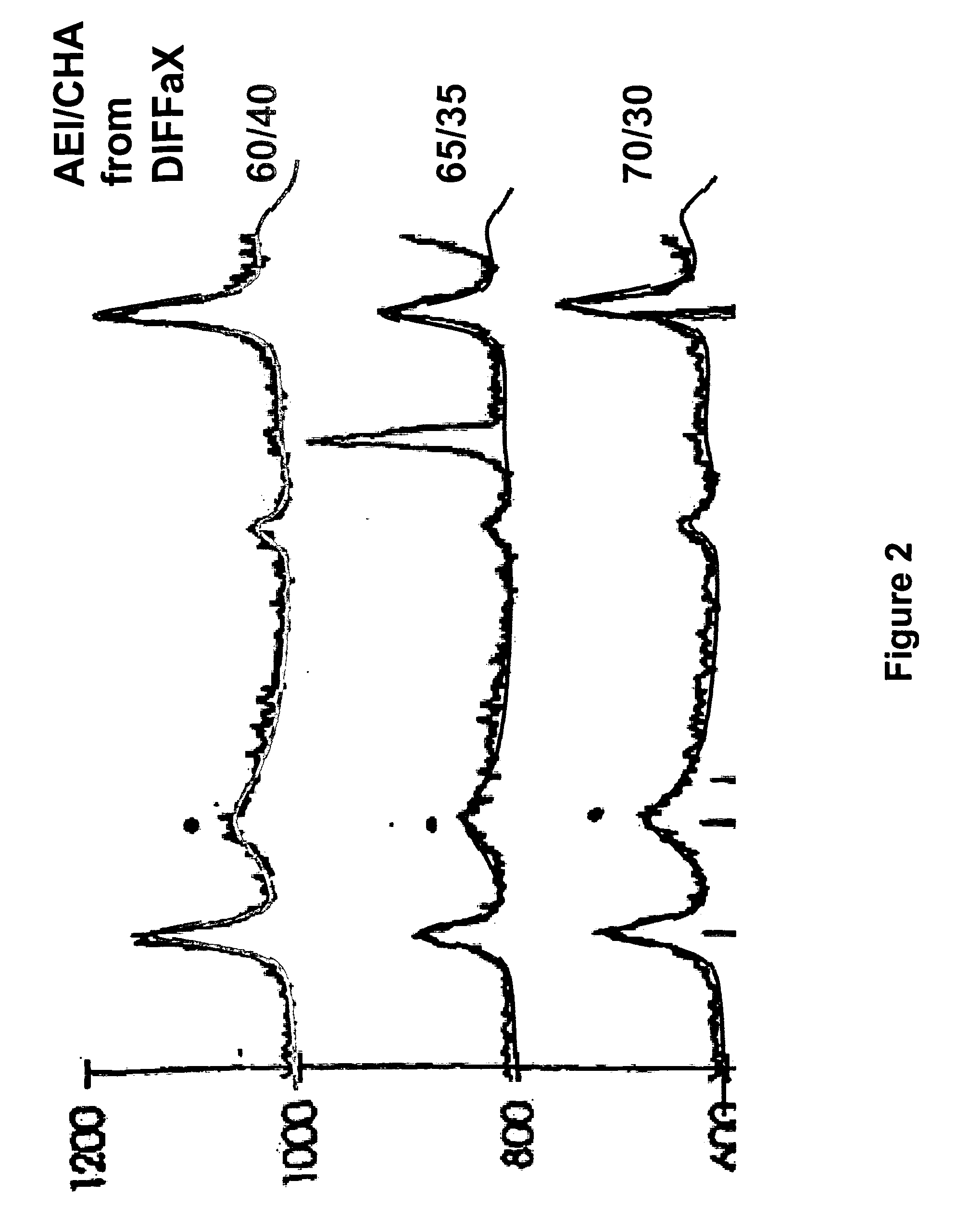Crystalline intergrowth material, its synthesis and its use in the conversion of oxygenates to olefins
a technology of crystalline intergrowth material and oxygenate, which is applied in the direction of hydrocarbon preparation catalyst, physical/chemical process catalyst, transportation and packaging, etc., can solve the problems of clogging cage, deactivating catalyst, and affecting the production of low-cost light olefins from petroleum feeds
- Summary
- Abstract
- Description
- Claims
- Application Information
AI Technical Summary
Benefits of technology
Problems solved by technology
Method used
Image
Examples
example 1
[0084] A mixture of 382.39 g of phosphoric acid (85% in water, Acros), 371.99 g of demineralized water and 706.79 g of tetraethylammonium hydroxide solution (35% in water, Sachem) was prepared in a 2 liter polyethylene bottle. The resultant mixture was then transferred to a glass beaker placed in a Neslab bath at 30° C. and, after initiating stirring of the mixture with a laboratory mixer, 29.83 g Ludox AS 40 (40% silica) was added to the beaker followed by 227.01 g of alumina (Condea Pural SB-1). A slurry was produced and was then aged for 2 hours in the Neslab bath at 30° C. with the stirring being continued. The composition of the mixture in terms of molar ratios was as follows:
0.12SiO2 / Al2O3 / P2O5 / TEAOH / 35H2O
[0085] The mixture was transferred to a 2 liter PARR stainless steel autoclave and heated at a rate of 20° C. / hour to 165° C. The mixture was stirred with a laboratory mixer at 200 rpm (tip speed of 1.3 m / s) during the whole hydrothermal treatment. The autoclave was kept at...
examples 2 to 11
[0086] THE procedure of Example 1 was repeated but with the amounts of the starting materials being adjusted to produce reaction mixtures having the silica to alumina molar ratios (Si / Al2) set out in Table 2 below. Crystallization was conducted in the same manner as described in Example 1 although in some cases, as shown in Table 2, the crystallization time was increased to 72 hours. The silica to alumina molar ratios, d50 particle sizes of the washed slurries and the AEI / CHA ratios of the final products are also given in Table 2.
TABLE 2(Si / Al2)Cryst.(Si / Al2)AEI / CHAExampleMixTime (hrs)ProductPhase 1Phase 2Overalld50 μm10.12600.1610 / 9045 / 5527 / 731.852%48%20.10600.1310 / 9045 / 5527 / 731.950%50%30.11600.14 n / a*n / an / a1.840.12720.1610 / 9045 / 5526 / 741.755%45%50.13600.1810 / 9045 / 5528 / 721.847%53%60.14600.1810 / 9045 / 5527 / 731.746%54%70.15600.19n / an / an / a1.580.15720.19n / an / an / a1.790.15720.1910 / 9045 / 5528 / 722.050%50%100.20600.2310 / 9045 / 5528 / 721.448%52%110.20720.2210 / 9045 / 5526 / 741.455%45%
*n / a—not availab...
example 12
[0087] A sample of each of the crystalline materials from Examples 2 to 11 was loaded into a fixed bed reactor equipped with an on-line gas chromatograph and was used to convert a methanol-containing feed at a temperature of 450° C.; a WHSV between 800 and 1000 hr−1 and a methanol partial pressure of 40 psia (276 kPa). The methanol conversion activity of each of the materials, as the first order rate constant Kmax at the point at which the average methanol conversion was reached, was calculated according to the following equation:
Kmax (Hz)=−ln(1−Xm) / τ
where Xm is the maximum conversion of methanol, and [0088]τ is space time(sec).
[0089] The calculated Kmax values are plotted against the Si / Al2 of each sieve in FIG. 3a.
PUM
| Property | Measurement | Unit |
|---|---|---|
| molar ratio | aaaaa | aaaaa |
| molar ratio | aaaaa | aaaaa |
| molar ratio | aaaaa | aaaaa |
Abstract
Description
Claims
Application Information
 Login to View More
Login to View More - R&D
- Intellectual Property
- Life Sciences
- Materials
- Tech Scout
- Unparalleled Data Quality
- Higher Quality Content
- 60% Fewer Hallucinations
Browse by: Latest US Patents, China's latest patents, Technical Efficacy Thesaurus, Application Domain, Technology Topic, Popular Technical Reports.
© 2025 PatSnap. All rights reserved.Legal|Privacy policy|Modern Slavery Act Transparency Statement|Sitemap|About US| Contact US: help@patsnap.com



